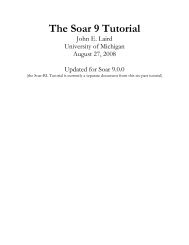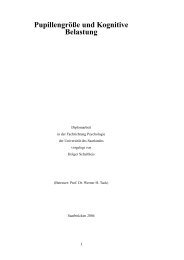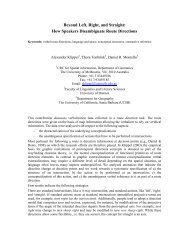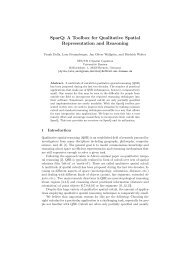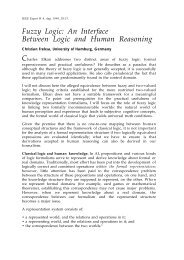Schematic Maps for Robot Navigation - the Cognitive Systems Group
Schematic Maps for Robot Navigation - the Cognitive Systems Group
Schematic Maps for Robot Navigation - the Cognitive Systems Group
Create successful ePaper yourself
Turn your PDF publications into a flip-book with our unique Google optimized e-Paper software.
One of <strong>the</strong> reasons <strong>for</strong> this is that we can expect a larger number of rare or unique<br />
configurations on <strong>the</strong> coarser and higher level of representation. This should make <strong>the</strong><br />
approach ra<strong>the</strong>r robust against perturbations due to incomplete, imprecise and even<br />
partially conflicting knowledge. When spatial relations found in <strong>the</strong> map and in <strong>the</strong><br />
spatial environment do not match perfectly, conceptual neighborhood knowledge<br />
(Freksa, 1992a, b) can be used to determine appropriate matches.<br />
Fur<strong>the</strong>rmore, in realistic settings suitable reference in<strong>for</strong>mation usually will be<br />
available to simplify <strong>the</strong> problem of matching <strong>the</strong> map to <strong>the</strong> environment. Like in<br />
route instructions to fellow human beings we can in<strong>for</strong>m a robot about its own<br />
location on <strong>the</strong> map and possibly about its orientation in <strong>the</strong> environment. O<strong>the</strong>r<br />
locations may be indicated by unique landmarks or rare objects that <strong>the</strong> robot should<br />
be able to recognize. These measures help control <strong>the</strong> number of possible matches<br />
between map and environment.<br />
This leads us to <strong>the</strong> problem of object recognition. Here we adopt a coarse,<br />
qualitative approach, as well. Ra<strong>the</strong>r than attempting to recognize objects from details<br />
in visual images, our strategy is to identify configurations through ra<strong>the</strong>r coarse<br />
classification and by employing knowledge as to how <strong>the</strong>se configurations may be<br />
distorted by <strong>the</strong> perception and by matching processes. For example, we use coarse<br />
color and distance in<strong>for</strong>mation to identify landmarks in our indoor office scenario. We<br />
may relate our approach to Rosch’s findings of linguistic categories in human<br />
communication (Rosch, 1975). Rosch found that <strong>the</strong> basic conceptual categories<br />
people use in communication tend to be nei<strong>the</strong>r <strong>the</strong> very specific nor <strong>the</strong> very general<br />
categories but intermediate categories that may be most suitable <strong>for</strong> object<br />
identification and concept adaptation.<br />
Multimodal in<strong>for</strong>mation 3 , <strong>for</strong> example a combination of color, distance, and<br />
ordering in<strong>for</strong>mation, can support <strong>the</strong> identification process on <strong>the</strong> level of high-level<br />
conceptual entities and structures considerably, as <strong>the</strong> use of different feature<br />
dimensions helps select appropriate matching candidates.<br />
5.1 Creating <strong>Schematic</strong> <strong>Maps</strong><br />
<strong>Schematic</strong> maps can be created in at least three different ways: (1) by a human<br />
observer / instructor; he or she can acquire knowledge about <strong>the</strong> spatial layout of <strong>the</strong><br />
environment through inspection and can put down relevant relationships in a<br />
schematic map. The actual layout of that map can be supported by a computerized<br />
design tool that creates a simple regularly structured map and helps making sure <strong>the</strong><br />
depicted relations can be interpreted in <strong>the</strong> intended way; (2) by <strong>the</strong> robot itself; in its<br />
idle time, <strong>the</strong> robot can explore its environment, note landmarks, and create a<br />
schematic map that reflects notable entities and <strong>the</strong>ir spatial relationships as<br />
discovered from <strong>the</strong> robot’s perspective; (3) from a spatial data base: <strong>for</strong> artificial<br />
environments data about <strong>the</strong> kinds of objects and <strong>the</strong>ir locations may be specified in a<br />
data base; this in<strong>for</strong>mation can be fed into a computerized design tool to create a<br />
schematic map, as well.<br />
3 We use <strong>the</strong> term ‘multimodal’ in a ra<strong>the</strong>r general sense. It refers to conceptual as well as to<br />
perceptual categories.



